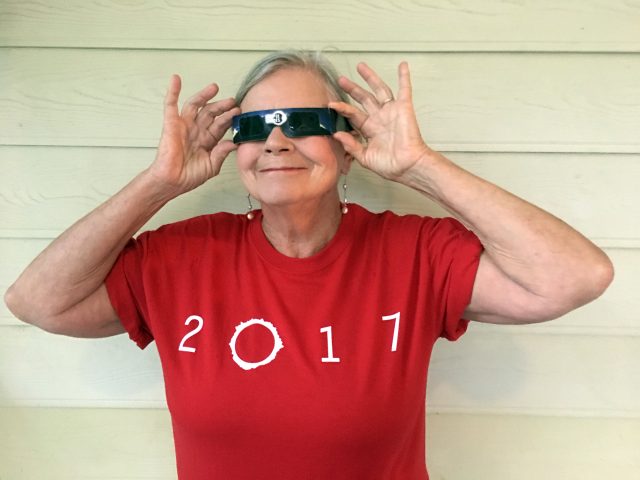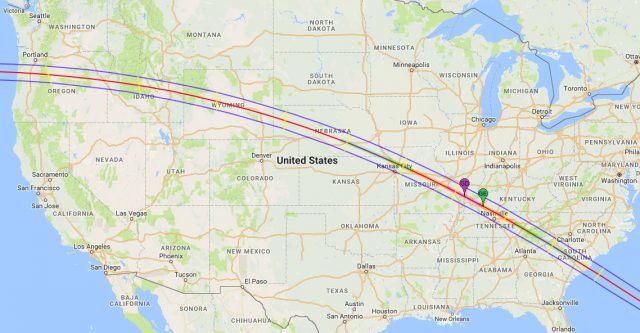08/04/2017 – Anticipating an Eclipse (Karen Benson)

A safe way to look at the eclipsing sun directly is to wear special “eclipse glasses.” The dark plastic film blocks out almost all of the light. Robert Benson photo.
The Great 2017 American Eclipse
You are probably aware that there is to be a total eclipse of the sun later this month. This is the first one to occur in the continental United States in over 38 years. The last one was on February 26, 1979 and it could only be seen in five states in the Pacific Northwest. This upcoming one, dubbed “The Great American Eclipse” is garnering a lot of media attention. And, well it should! The solar eclipse of 2017 is going to be visible all across America, from coast to coast!
On the morning of Monday, August 21, 2017, the eclipse will start out in the Pacific Ocean. The shadow will make its first landfall at Yaquina Head on the Oregon coast. The shadow will then arc its way eastward across the center of the United States for the next hour and a half. The last place to see the total eclipse in the continental US will be Charleston, South Carolina.
National Geographic Magazine, (August 2017), states that “the sun will be totally obscured by the moon in the approximately 70-mile wide shadow called the umbra.” Outside this path, in the penumbra, viewers can see a partial eclipse. In the penumbra, fifty percent of the sun will be covered by the moon as far north as mid-Canada and as far south as south Texas.

The upcoming eclipse will travel across the whole of the continental United States. The path of totality is 70 miles wide and stretches from Oregon to South Carolina. Inside that band, observers will see the sun go totally dark for over two minutes. The purple dot indicates the point of “greatest duration” which is where the eclipse will last for two minutes and 40 seconds. The green dot is the point of maximum alignment of moon and earth. NASA map.
I have seen a partial solar eclipse. Although not spectacular, it was still pretty cool. I recall we made a pinhole projector, using two pieces of cardboard (one of them should be white) and a small square of aluminum foil. We cut a small hole in one of the pieces of cardboard, taped the foil over the hole, and then used a sharp needle to make a tiny hole in the foil. We held this simple device up to the sun, with the sun at our backs, and let the sun’s light project a disk on to the white sheet of cardboard. We could see the sun’s disk being “eaten away” by the moon’s shadow in real time. This is a safe and inexpensive way to observe a partial eclipse.
Of course, you never should look directly at the sun. The high-energy sun’s rays can damage your eyes, even causing blindness. Ordinary sunglasses will not provide sufficient protection. The simplest way you can look directly at an eclipsing sun is to wear “eclipse glasses.” These are made of a very dark, plastic film that blocks UV and light rays to just one millionth of the intensity of the sun. That’s right, I said “one-millionth of the intensity.” Be sure the glasses have been labelled ISO & CE Certified Safe Solar Eclipse Shades. That is what is needed to look directly at the sun.
Where can one get such eclipse glasses? I have not seen any sold locally but they may be available closer to the time of the eclipse. You can purchase them online, but several of the suppliers are already sold out. One supplier, rainbowsymphony.com says on their website that they will have them again on August 6th. Be sure to check Amazon.com as well. But don’t wait any longer to order eclipse glasses if you want to have them in time!
Ironically, you do not need to wear eclipse glasses during the two and a half minutes of totality, if you are on the path of totality. In fact, if you do wear them when the sun’s disk is completely covered by the sun you will see nothing. So, observers are coached to use the eclipse glasses as the eclipse is waxing and waning, but to take them off during totality.
What can one expect to see during totality? Again, National Geographic says “The sun’s corona—the dramatic, outermost atmosphere made of plasma and superheated to an unknown temperature—is believed to be several million degrees Fahrenheit. It’s visible to the naked eye only during a total solar eclipse, inside the umbral shadow.” The corona projects outward loops, arcs and prominences at the edges of the solar disk that are spectacular to behold.
This is why at 11:30AM Mountain Time on August 21st I will be just north of Laramie, Wyoming. We planned this trip for months. Other eclipse chasers have planned for years, making their reservations for campsites, wineries, lighthouses, and national monuments along the path of totality well in advance.
Some communities along the path are preparing feasts and festivals. Madras, Oregon (the top-ranked viewing spot in the United States) has been organizing its OregonSolarfest for over five years! Madras is providing camping (now sold out) and a shuttle service from bigger Oregon cities to make sure everyone gets to see the eclipse. The infrastructure for such an event must be amazing.
Alliance, Nebraska is another top spot. It is the site of the #2 Wackiest Attraction by TripAdvisor: Carhenge. Carhenge is modeled after Stonehenge but it is built of vintage American automobiles sunk in the ground. There, you can observe the total eclipse over the three standing stones (er…cars) at the center of the circle. Each to his own, I guess….
In Beeville, Texas, the partial solar eclipse begins at 11:43PM CDT and lasts until 2:40PM. At its maximum, the sun will be about 58% covered. This drop in light intensity may not be noticeable to the naked eye. At best, you will observe a slight golden color to the daylight. You may feel the temperature drop, however. Therefore, I strongly recommend you build a pinhole projector and/or get some eclipse shades for this almost once in a lifetime event. You won’t regret it
